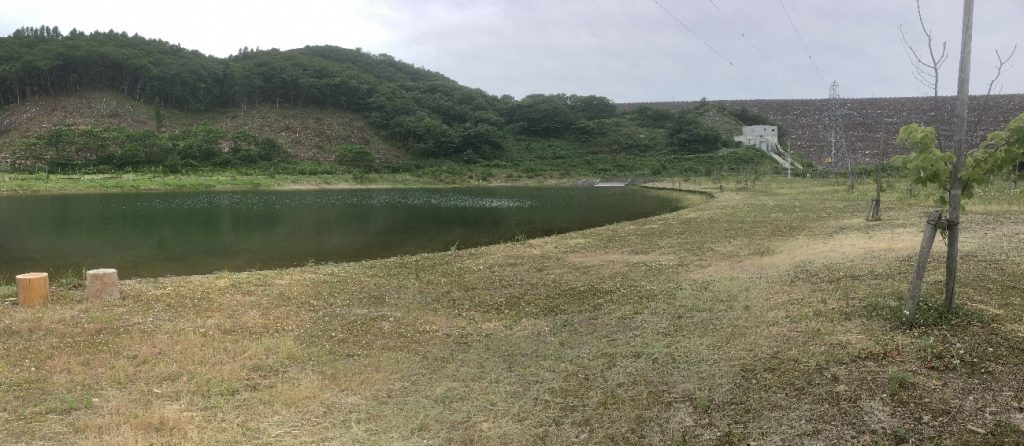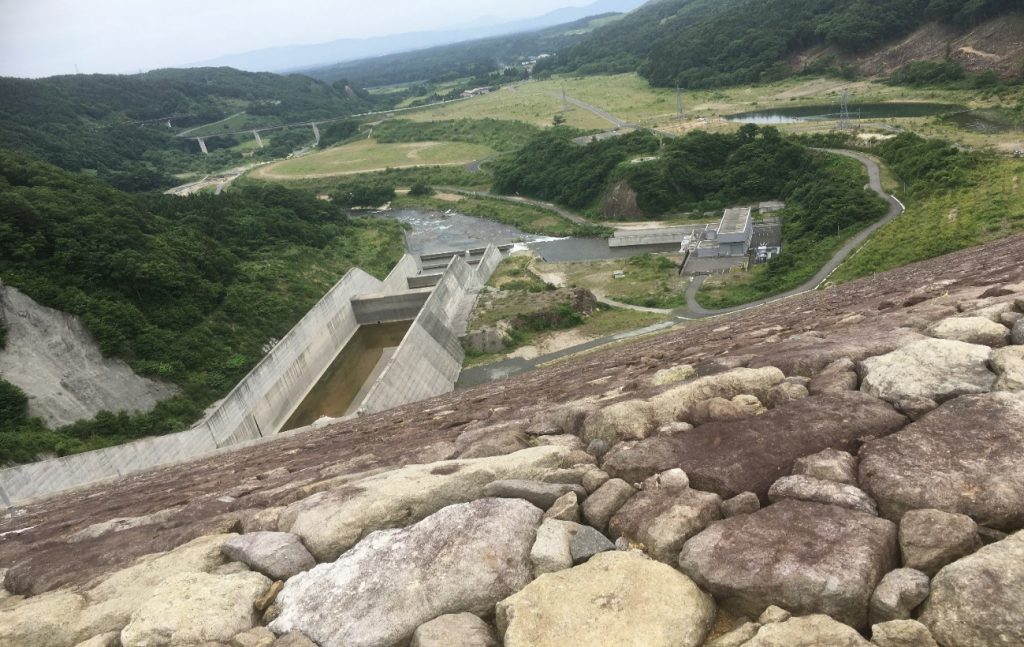Iwate in general, and Oshu in particular, is a place full of hidden gems. From Maesawa wagyu beef to a plethora of brilliant thinkers and writers, or the National Observatory and of course the prospective ILC, this city has a lot of incredible features, even though locals aren’t usually inclined to brag about them. A great example of this phenomenon is the Isawa Dam Canoe Course.
The Isawa Dam is on the Isawa River, and is the largest rock filled dam in Japan. On top of providing tap water, irrigation, and hydroelectric power, this dam is also the site of one of Japan’s premier canoe courses. Built right under the dam, the unpredictable nature of this course – in contrast to artificial courses – makes it a true challenge.
Last year, when preparations were going on with the intention of holding the Olympics in summer 2020, and we were coordinating discussions about holding training camps for certain international teams at this course, I had the amazing opportunity to meet and talk with Olympic athletes and affiliates. At that time, they sang the praises of Isawa’s course for its complexity, as well as its scenic backdrop. It was thrilling to watch them take on the fast rushing water, with a strength that was both physical and mental.
I’m pleased to report, however, that this weekend class – indeed all such classes –aren’t on this intense course, but on a still water pond for people to experience paddling a canoe in a relaxed, calm atmosphere. Anyone from grade 3 and up with any level of experience can join. These lessons take place every Saturday from May to September, one in the afternoon and one in the morning.
The deep green foliage contrasted beautifully against the light gray clouds, unlike the fall colors I had experienced last time I was here in November. After a brief warmup and explanation of how to paddle, we got in our boats and set off.
From here, it was very open-ended: you could paddle in any direction, at your own pace. The instructor circled around, offering tips as needed and helping out if anyone got stuck on shore. I paddled back and forth across the length of the pond, vacillating between a quick pace and a more leisurely one, pausing from time to time to rest and admire my surroundings.
There were exactly 10 participants, and we were all spread out. It’s an outdoor activity, of course, and the boats are single-rider, so it avoids the 3 C’s (or what Japan calls the 3 mitsu: crowds, close conversations, and closed-off spaces.) If you want to take extra care once it’s safe enough to visit Japan, canoeing is a great low-risk activity option.
After the class, I headed to the observation area to get a panoramic view of the dam. As I stepped onto the bridge, the view of most of the dam spread out before me was staggering. Looking closer, I could see our pond, with the canoes resting beside like little toy boats. Mountains, covered in trees of the richest green, were the backdrop of this scene. It was an easy place to sit on a bench and simply watch the water, trees, and clouds. Photos don’t do it justice.
On a practical note, as for food and lodging, nearby Himekayu Onsen offers overnight stays or day trip options. In addition to rejuvenating hot springs to soak in, seasonal foods made with local ingredients are on offer, plus an attached ski hill. On both the drive in and the return trip, one notices a tunnel of trees. This is known as the Tunnel of Cherry Blossoms: in spring, lovely light pink sakura bloom for a short time. No matter the season, this place has something unique and beautiful going on.
Thanks to the Isawa Dam and the course, Oshu City and the Oshu City Community Revitalization Corps have been able to promote the sport of canoe to the entire area. An association of canoe enthusiasts helps to prepare classes like this, canoe-centered festivals, tournaments, and more.
Among Iwate’s many secrets, this is one of its best-kept. Hope to see you there!
Links
Isawa Dam Tourism site (All in Japanese, click around for pictures of the site and past events.)
Link to Himekayu site (Also all in Japanese, but some gorgeous photos.)
Japanese
隠れた魅力:いさわダムカヌー岩手県もそうですが、特に奥州市は、様々な魅力に溢れています。前沢牛や偉人、国立天文台水沢VLBI観測所、それからもちろんILCなど、この地域には様々な特徴があります。もっと皆さんに知ってもらいたい魅力として、今回は奥州いさわカヌー競技場をご紹介します。
胆沢ダムは日本最大級のロックフィルダムであり、かんがい・上水道・発電に供給しているだけではなく、日本屈指のカヌー競技場が備わっています。ダムの直下に整備された競技場は、自然の川を活かしたコースで、荒々しい水の流れはなかなか予想が難しく、人工の競技場よりもチャレンジ精神がかき立てられます。
昨年、東京2020オリンピックの準備が進められていたとき、奥州いさわカヌー競技場で国際チームの強化キャンプ受入の検討がされていました。その頃、幸運にもオリンピック選手と話をする機会がありました。選手たちは、コースの複雑さや眺望の良さを絶賛していました。全身全霊を懸け荒れる水に挑むトップ選手の姿は、とてもスリリングなものでした。
初心者の私にとって、ちょうどよいコンテンツがあります。競技場の近くに穏やかな水面のため池があり、週末カヌー教室が開催されます。小学生3年生以上を対象として、経験の有無に関わらず、誰でもカヌーを漕ぐことができます。教室は、5月から9月までの毎週土曜日、午前と午後それぞれ一回ずつ開催されます。
私が前回ここに来たのは11月。その時は紅葉が鮮やかでした。今の季節、深緑の植物は薄い灰色の雲と美しいコントラストを彩っています。準備体操と漕ぎ方の説明を受け、カヌーに乗り出発しました。
漕ぎだした後は自分のペースで自由にカヌーを楽しみました。インストラクターは見回りながら、必要なアドバイスをしたり、手間取っている方を手伝ったりしていました。私はため池の広さいっぱいに漕いで、時折休憩しながら景色を眺めたり、速く漕いだり、ゆっくり漕いだりを繰り返しました。
カヌー教室の参加者は10人で、適度に距離を保てます。カヌーは屋外で実施しますし、各カヌーには1人しか乗らないため、3密を避けながら体験をすることができます。カヌーは比較的感染症のリスクが低いと言えると思います。
教室の後、眺望を楽しむため、ダム下流のため池からダム本体の所へ移動しました。ダムの天端(てんば、ダム堤体の一番上部。胆沢ダムでは歩道になっている)を歩くと、素晴らしい眺めが目の前に広がっていました。先ほどまでカヌーを漕いでいたため池は小さく、カヌーは玩具のように転がっていて、濃緑を着飾っている山々はこのシーンの背景となりました。ベンチに座って、ただただ水、木、雲をのんびりと見ることができる場所です。こののんびりとした雰囲気を写真では捉えられないと思います。
付近の飲食店や宿泊施設については、ひめかゆ温泉で日帰り入浴や宿泊を提供しています。爽やかな温泉のみならず、地元食材で作られた季節の料理もあり、さらにスキー場もあります。また、ダムの帰り道に、「桜の回廊」という桜の並木があり、春にはこの辺が淡いピンク色に染められます。この地ならではの四季折々の美しい表情があります。
胆沢ダムと競技場から、奥州市や地域おこし協力隊はカヌーを振興し、教室、ダムフェスタ、カヌー大会などの活動を進めています。
岩手県の隠れた魅力の中で、胆沢ダムは指折りの場所です。お待ちしております!
胆沢ダム観光ホームページリンク:
https://www.oshu-kankou.jp/isawa-dam/dam-lake.html
(日本語のみ、胆沢ダム周辺や過去イベントなどの写真があります。)
ひめかゆ温泉ホームスクーリング:http://www.himekayu.com/bath.php
(日本語のみ、美しい写真が掲載されています。)







